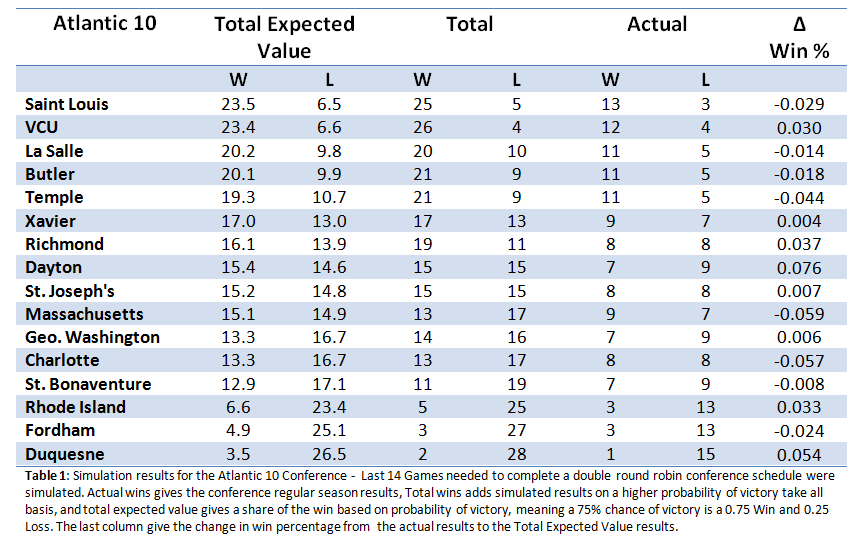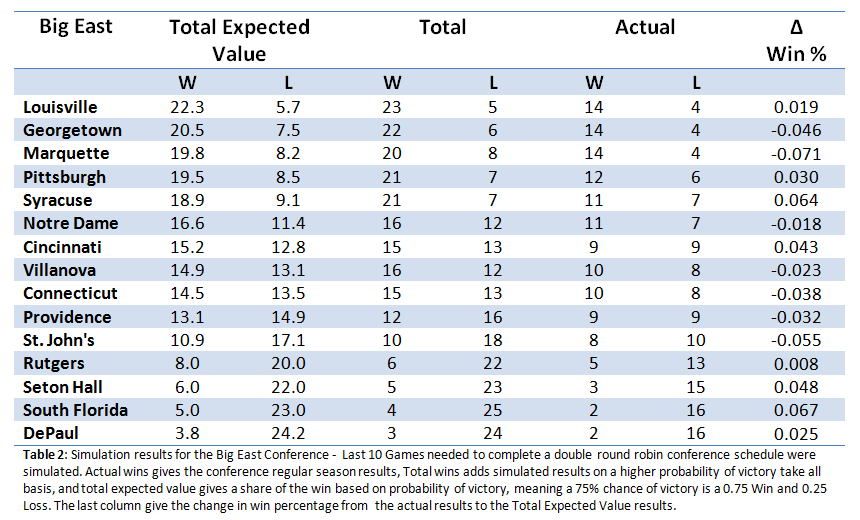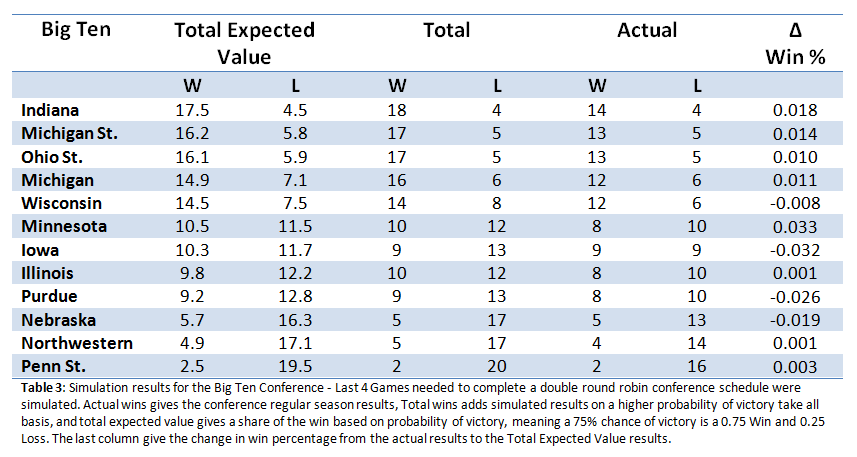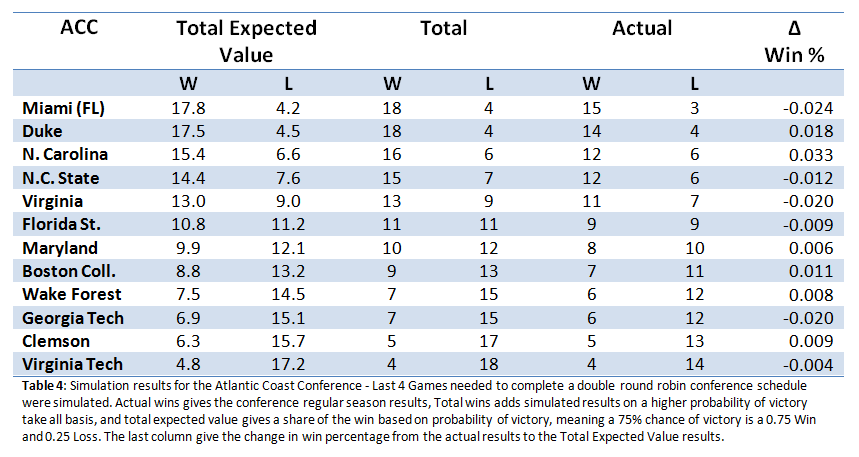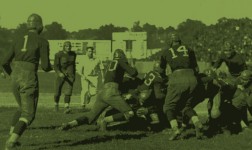By Zachary Hass and Tom Neilsen, purdue university
Listen to Zach discuss his research on our podcast series:
As conferences grow in size it becomes increasingly difficult, sometimes impossible, to have a double round-robin conference schedule. Yet a scheduling scheme that allows each team to play one home and one away game against all conference members is the most equitable way to decide the regular season conference champion. Injuries, streaks, and other uncontrollable factors will certainly introduce inequity into schedules, but failing to play all conference opponents is controlled by the schedule makers.
In a perfect world, the schedules will still be set in such a way that each team still has roughly the same level of difficulty to attain the conference crown. On the other end of the spectrum a lesser team might sneak into the top spot by playing a relatively easier slate of games, getting tougher teams at home only or maybe not at all.
Of the 32 Conferences in Division 1, 18 played a double round-robin schedule this past season and 14 did not. The split, as might be expected is based on the number of teams in the conference. With the exception of the Colonial Athletic Conference (11 teams), the incomplete schedule conferences have 12 or more teams.
Two basic schemes seem to exist in which games are left un-played. Either conferences are split in half or left as one group. If split, a team will play everyone twice in their own half, and once in the other half. If left as a whole, each team will leave a certain number of games un-played evenly split between home and away games. Despite the sound and balanced rationale in which games are left un-played, the question still remains, how fair is it in practice?
In larger conferences, such as the Big East and the Atlantic 10, the sheer number of games un-played is worth examining, especially with how few games separate the top finishers. In conferences like the Big Ten or the Atlantic Coast Conference, with fewer games left un-played, the close finishes places greater importance upon which games were left un-played. Additionally, the 13 team Mid-Eastern Athletic Conference is of interest.
The MEAC schedule this year featured several oddities. Some teams never faced each other, the number of home and away games for each team was not always balanced, and the number of teams faced twice was not the same for each team. Of particular importance, is that the top two teams Norfolk St. (16-0) and N.C. Central (15-1) did not face each other a single time.
In order to examine how fair or unfair un-played scheduling was this last year, we used simulations to round out the schedule for the Big East, Atlantic 10, Big Ten, ACC, and to look at the Norfolk St, N.C. Central matchup.The model was built based on regular season results, estimating offensive and defensive strengths of each team, taking into account opponents and home field advantage.
Each matchup was simulated 10,000 times, giving each team a probability of winning the game. We tabulated the wins two ways, first giving the team with the higher probability the win, and second giving each team a share of the win based on their probability. This second method, a sort of ‘Expected Win’ gives a better feel for how close or far apart teams’ performance might be across those simulated games. For example, the simulations report that Miami (FL) at home has a 77% chance of beating N.C. State. This would give Miami 0.77 of a win and N.C. State 0.23 of a win to reflect the fact that Miami appears to be the stronger team, but the game did not actually take place.
The Atlantic 10 Conference left the most games un-played of any conference with each team missing 14 matchups. At season’s end, Saint Louis was one game ahead of Virginia Commonwealth University, with three other teams two games back, Table 1 gives the final standings. Actual wins and losses refer to the pre-conference tournament standings. Total wins and losses are the actual wins and losses plus the simulated wins and losses (giving the team with the higher probability the win). Standings are sorted by the Total Expected Value wins and losses, which sum the actual and simulated games calculated by giving each team a share of the win according to their probability of victory.
It should be noted that Saint Louis did not play at VCU or at La Salle, sitting in 2nd and 3rd place respectively. Had these games been played, VCU certainly would have had opportunity to overtake Saint Louis. Using the higher percentage takes all tabulation of wins, VCU would indeed overtake Saint Louis. Looking at expected wins, the two teams are nearly dead even. Since the standings have not changed much from the actual end of season results to the simulation final results, the model supports that the A10 Conference did a good job balancing the schedule, no great inequity exists.
Atlantic 20 Simulated Standings with Full Double Round-Robin Conference Schedule
The Big East is the only other conference to leave double digit games un-played with 10 such games. Three teams shared the regular season title with Georgetown, Louisville, and Marquette each at 14-4, with three teams at two games or less out of first place; very cluttered at the top. With eight teams invited to the NCAA tournament, it would be intriguing to see who would finish on top if those 10 games were to be played. Results of the simulations are given in Table 2. The table shows that the model predicts Louisville would finish on top by at least a game in both metrics. Since Louisville got a share of the title regardless, and given that a 28 game conference schedule is hardly feasible, it would appear that the Big East also did a very good job balancing the un-played games.
Big East Simulated Standings with Full Double Round-Robin Conference Schedule
The Big Ten Conference, one of the strongest leagues in the nation this year, left four games un-played. Indiana finished on top at 14-4, with Michigan St. and Ohio St. one game behind. Indiana did not play at Wisconsin or home verse Illinois, two teams that accounted for half of Indiana’s conference losses. Michigan State’s remaining games are home verse Iowa and Penn St., and at Illinois and Northwestern. All of those teams finished at or below 0.500 in the conference.
Ohio State’s remaining four games are also against 0.500 or worse teams in conference. It would seem that the last four games provide an opportunity for a different champion. Simulation results are given in Table 3. The model, however, predicts that Indiana would hold on to their one game lead, indicating that the scheduling did not greatly affect the Big Ten Champion’s road to the top.
Big Ten Simulated Standings with Full Double Round-Robin Conference Schedule
Like the Big Ten, the Atlantic Coast Conference left four games un-played. Unlike the Big Ten though, only two teams look to have a serious bid for the title with only four games left to play. Miami (FL) took the regular season crown at 15-3, with Duke one game behind. Miami did not travel to Virginia or Maryland, and would also need to host N.C. State and Wake Forest. Outside of a home game against Clemson, the three remaining opponents for Duke are 0.500 or worse in conference. The model predicts that Duke would stand a good chance of sharing the ACC title at 18-4. It would seem that Duke was put at a slight disadvantage by the scheduling. Still, there is no great change in the standings generally, indicating that like the other three conferences, the ACC did a good job setting the schedule.
ACC Simulated Standings with Full Double Round-Robin Conference Schedule
Lastly we simulated both games between Norfolk St. and N.C. Central out of the MEAC, the 1st and 2nd place teams in the conference respectively. The model indicates that N.C. Central would have won their home game with a 75% probability and also won the away game with a much narrower 51% chance. Had one or both of those games been played, it certainly would have given N.C. Central a chance to erase the one game deficit and capture the conference regular season crown.
It is evident from the simulations that there is some inequity in scheduling without using the double round-robin format, as the tie was broken in the Big East and a tie was formed in the ACC. But it is clear that for the most part standings remain unchanged with the addition of the un-played games.
The only scheduling format that could stand for improvement, unknown scheduling restrictions aside, is the Mid-Eastern Athletic Conference. It is a great misfortune to have the top two teams fail to face each other and still award one a conference championship, if it can at all be avoided. By and large though, the conferences appear to do an exceptional job balancing their schedules with respect to equity in un-played games.
Zachary Hass is a graduate of Case Western Reserve University where he played safety for the football team and holds a degree in Statistics and Economics. Currently he is working on a MS of Applied Statistics at Purdue University.
Thomas Nielsen is a graduate of Purdue University where he received a Bachelor’s Degree in Mathematical Statistics and a Master’s Degree in Applied Statistics. He currently works for an analytics company near Chicago.
Key Insights
The difficulty of arranging double round-robin schedules for conferences leaves questions about the fairness at the end of the year. Ideally the schedules would be set so that each team has the same level of difficulty to attain the conference crown. We simulated each matchup 10,000 times, giving each team a probability of winning the game and tabulated the wins two ways, first giving the team with the higher probability the win, and second giving each team a share of the win based on their probability. We found that largely conferences appear to do an exceptional job balancing schedules with respect to equity in un-played games.


